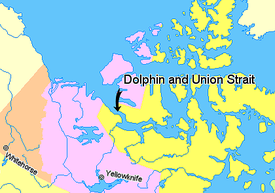
Dolphin and Union Strait
Encyclopedia

Northwest Territories
The Northwest Territories is a federal territory of Canada.Located in northern Canada, the territory borders Canada's two other territories, Yukon to the west and Nunavut to the east, and three provinces: British Columbia to the southwest, and Alberta and Saskatchewan to the south...
and Nunavut
Nunavut
Nunavut is the largest and newest federal territory of Canada; it was separated officially from the Northwest Territories on April 1, 1999, via the Nunavut Act and the Nunavut Land Claims Agreement Act, though the actual boundaries had been established in 1993...
, Canada
Canada
Canada is a North American country consisting of ten provinces and three territories. Located in the northern part of the continent, it extends from the Atlantic Ocean in the east to the Pacific Ocean in the west, and northward into the Arctic Ocean...
, between the mainland and Victoria Island. It links Amundsen Gulf
Amundsen Gulf
Amundsen Gulf is a gulf located in Canadian Northwest Territories, between Banks Island and Victoria Island and the mainland . It is approximately in length and about across where it meets the Beaufort Sea....
, lying to the northwest, with Coronation Gulf
Coronation Gulf
Coronation Gulf lies between Victoria Island and mainland Nunavut in Canada. To the northwest it connects with Dolphin and Union Strait and thence the Beaufort Sea and Arctic Ocean; to the northeast it connects with Dease Strait and thence Queen Maud Gulf. To the southeast lies Bathurst...
, lying to the southeast. The southeastern end of the strait is marked by Austin Bay
Austin Bay (Nunavut)
Austin Bay is an Arctic waterway in Kitikmeot Region, Nunavut, Canada. It is located in Dolphin and Union Strait, by southwestern Victoria Island. It is separated from the Coronation Gulf by a small peninsula....
.
The Inuit
Inuit
The Inuit are a group of culturally similar indigenous peoples inhabiting the Arctic regions of Canada , Denmark , Russia and the United States . Inuit means “the people” in the Inuktitut language...
who use this area have been variously known as the Copper Eskimo
Eskimo
Eskimos or Inuit–Yupik peoples are indigenous peoples who have traditionally inhabited the circumpolar region from eastern Siberia , across Alaska , Canada, and Greenland....
s, the Copper Inuit
Copper Inuit
Copper Inuit are a Canadian Inuit group who live north of the tree line, in Nunavut's Kitikmeot Region and the Northwest Territories's Inuvik Region. Most historically lived in the area around Coronation Gulf, on Victoria Island, and southern Banks Island.Their western boundary was Wise Point,...
or, the "People at the end of the world," because few other aboriginal groups
Aboriginal peoples in Canada
Aboriginal peoples in Canada comprise the First Nations, Inuit and Métis. The descriptors "Indian" and "Eskimo" have fallen into disuse in Canada and are commonly considered pejorative....
had continuously used the area before. This is partly why the first explorers who ventured into this awe-inspiring, lethally-formidable landscape, were amazed by the "blond" Inuit
Blond Eskimos
Blond Eskimos is a term first applied to sightings and encounters of light haired indigenous peoples of the Arctic Circle region from the early 20th century, particularly around the Coronation Gulf between mainland Canada and Victoria Island...
they had encountered.
There are several islands within the strait, including the Liston and Sutton Islands, historically home to the Noahonirmiut band of Copper Inuit.
The strait is about 161 km (100 mi) long and ranges from 32 kilometre in width. When frozen, it is used by Barren-ground Caribou
Barren-ground Caribou
Barren-ground Caribou is a subspecies of the caribou that is found mainly in the Canadian territories Nunavut and the Northwest Territories and western Greenland. It sometimes includes the similar porcupine caribou, in which case the barren-ground caribou also is found in Alaska...
, labeled the "Dolphin and Union" herd, to reach Victoria Island] for the summer and to return to the mainland for the winter. Eider
Eider
Eiders are large seaducks in the genus Somateria. Steller's Eider, despite its name, is in a different genus.The three extant species all breed in the cooler latitudes of the Northern hemisphere....
ducks are also found in the strait.
The caribou are known locally as Tuktu which is understood across the circumpolar world. Conversely, Eider ducks are called Kingalik which means simply, Big-Nose.
In recent decades, the local Inuvialuit
Inuvialuit
The Inuvialuit or Western Canadian Inuit are Inuit people who live in the western Canadian Arctic region. They, like all other Inuit, are descendants of the Thule who migrated eastward from Alaska...
have seen the reduction in average winter sea-ice thickness from roughly 6 foot in the early 1960s to about 110 centimetre even in the dead of winter today. There is also a preponderance of new species from flies to wasps, and new birds arriving that have never been seen before; grizzlies
Grizzly Bear
The grizzly bear , also known as the silvertip bear, the grizzly, or the North American brown bear, is a subspecies of brown bear that generally lives in the uplands of western North America...
roam where they were once that most rare curiosity.

